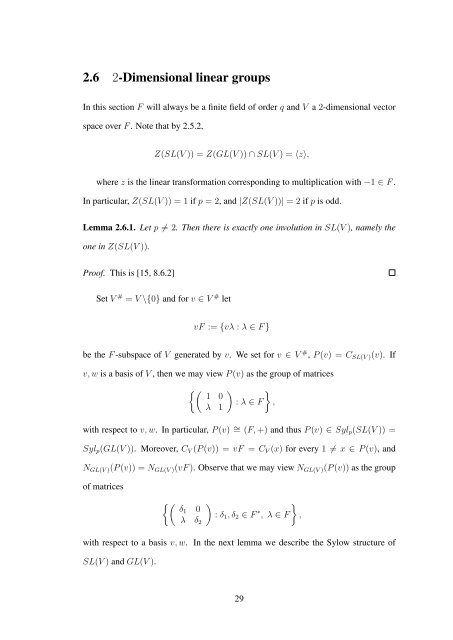SATURATED FUSION SYSTEMS OF ESSENTIAL RANK 1
SATURATED FUSION SYSTEMS OF ESSENTIAL RANK 1
SATURATED FUSION SYSTEMS OF ESSENTIAL RANK 1
You also want an ePaper? Increase the reach of your titles
YUMPU automatically turns print PDFs into web optimized ePapers that Google loves.
2.6 2-Dimensional linear groups<br />
In this section F will always be a finite field of order q and V a 2-dimensional vector<br />
space over F . Note that by 2.5.2,<br />
Z(SL(V )) = Z(GL(V )) ∩ SL(V ) = 〈z〉,<br />
where z is the linear transformation corresponding to multiplication with −1 ∈ F .<br />
In particular, Z(SL(V )) = 1 if p = 2, and |Z(SL(V ))| = 2 if p is odd.<br />
Lemma 2.6.1. Let p �= 2. Then there is exactly one involution in SL(V ), namely the<br />
one in Z(SL(V )).<br />
Proof. This is [15, 8.6.2]<br />
Set V # = V \{0} and for v ∈ V # let<br />
vF := {vλ : λ ∈ F }<br />
be the F -subspace of V generated by v. We set for v ∈ V # , P (v) = CSL(V )(v). If<br />
v, w is a basis of V , then we may view P (v) as the group of matrices<br />
�� 1 0<br />
λ 1<br />
�<br />
�<br />
: λ ∈ F ,<br />
with respect to v, w. In particular, P (v) ∼ = (F, +) and thus P (v) ∈ Sylp(SL(V )) =<br />
Sylp(GL(V )). Moreover, CV (P (v)) = vF = CV (x) for every 1 �= x ∈ P (v), and<br />
NGL(V )(P (v)) = NGL(V )(vF ). Observe that we may view NGL(V )(P (v)) as the group<br />
of matrices<br />
�� δ1 0<br />
λ δ2<br />
�<br />
: δ1, δ2 ∈ F ∗ �<br />
, λ ∈ F ,<br />
with respect to a basis v, w. In the next lemma we describe the Sylow structure of<br />
SL(V ) and GL(V ).<br />
29

















